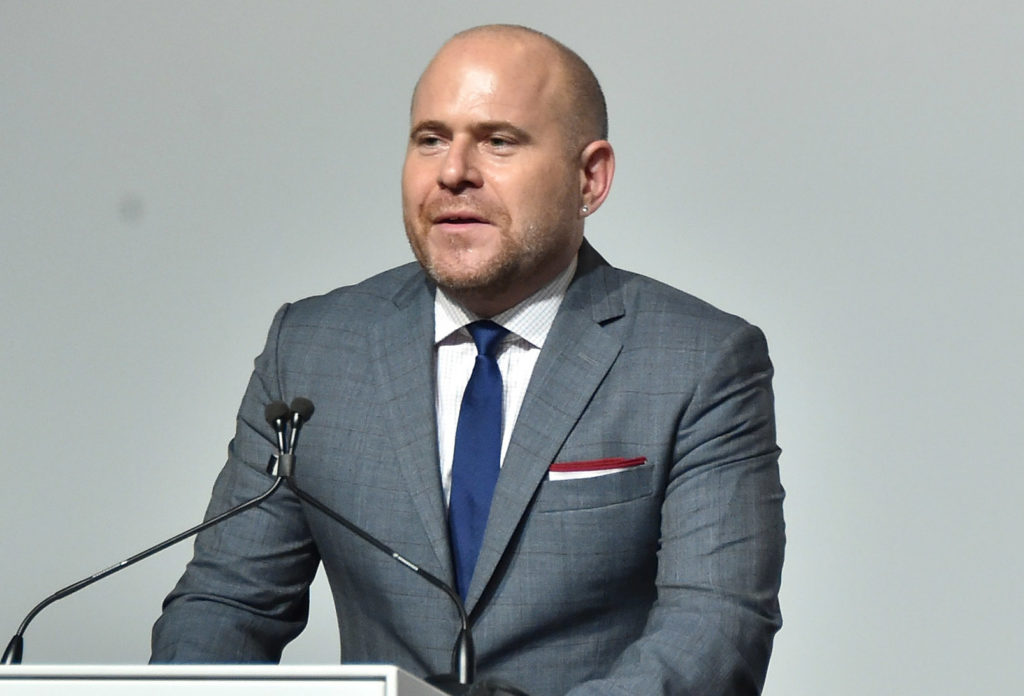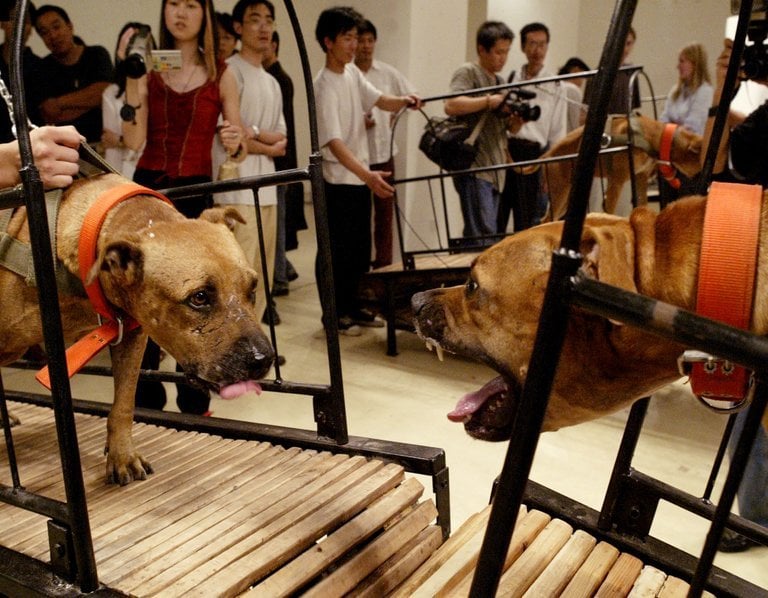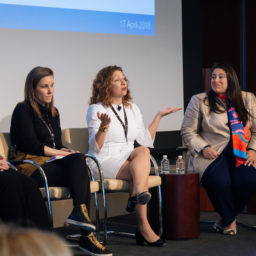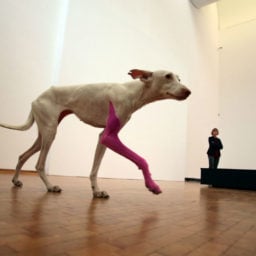Every Monday morning, artnet News brings you The Gray Market. The column decodes important stories from the previous week—and offers unparalleled insight into the inner workings of the art industry in the process.
This week, assessing the industry through matters of principle…
PRACTICE MAKES PERFECT: On Friday, Art Basel released its Art Market Principles and Best Practices, a sleek document consisting of two separate sections: a set of suggested guidelines for the fair’s exhibitors, and a Legal Compliance Process governing “cases involving intentional criminal activity directly related to an Exhibitor’s professional art-market activities.”
In my eyes, the document also represents a manifesto with the possibility to impact at least some aspects of the larger industry. To see why, let’s take a typical Gray Market deep dive. Luckily, though, we don’t need to rely on any of those fang-toothed, light-emitting nightmare fish to find our way through, since Art Basel Global Director Marc Spiegler was willing to answer a few of my questions by phone over the weekend.
Here are my three main takeaways from our conversation:
1) Art Basel’s guidelines are less a reaction to the past than an attempt to get ahead of the future
According to Spiegler, the document is something that Art Basel has been working through for “a couple of years.” Aside from a coterie of dealers and art attorneys, the organization also sought input from a standing group of gallerists drawn from its Basel, Hong Kong, and Miami Beach selection committees that it uses “precisely for addressing these cross-fair, market-wide issues.”
In this case, the issues were forward-facing. The document is intended to be “about anticipating a potential problem” that hasn’t yet happened, not belatedly reacting to some past lapse that snuck up on Art Basel like a goddamn ninja during a moonless night. And one important component of protecting the organization’s neck is ensuring that its personnel remains focused largely on their specific areas of expertise.
“Part of it,” Spiegler said “is about understanding the context of the types of situations that could arise and not putting it on our [exhibitor] selection committee to deal with. It’s not fair to ask them to understand what’s happening in the legal system six time zones away” in order to render a decision on a dealer’s possible inclusion in Art Basel.
Much better to have trained legal experts parsing those issues, especially as the art market continues to expand beyond a tight, clubby fraternity of insiders to include more and more transactions between people who don’t already know each other.
2) It was essential (and exhausting) to get to simplicity
To me, the most pleasantly surprising aspect of the document is its conciseness. The Best Practice Guidelines (Section 1) clock in at a svelte 528 words. And while it’s comparatively longer at 2,300 words, the Legal Compliance Process (Section 2) is still light years away from Infinite Jest.
“It was a complicated thing to write,” Spiegler says, “but in the end it’s a relatively simple document.” The goal was to create “something that would apply for hundreds of galleries across dozens of countries” yet “wouldn’t cause galleries to have to rethink the fundamentals of how they do their business.”
The result, in my interpretation, is a set of guidelines that you can only be upset about if you’re actively trying to defraud people. Just consider item 1.5 in the Best Practice Guidelines:
1.5 Exhibitors shall only sell works that they are authorized by the owner to sell, and only on the terms approved by the owner.
I mean, if you’re a dealer, railing against suggestions like this would be as self-incriminating as bellowing, “He was a whore and I’m glad he’s dead!” while you’re on trial for murdering your spouse.
Furthermore, it’s important to emphasize that Section I of the document is indeed just a set of suggestions. As Spiegler explains, “The Best Practices are not in any way binding. They’re just an attempt to lay out what we think is a solid way to do business. No one is going to get rejected from Art Basel because of the way they do or don’t invoice”—at least, as long as their procedure doesn’t involve any actual criminal activity, in which case they would be shuttled over to the Legal Compliance board for review.
3) For Art Basel, the document is about identity and reciprocal influence, not innovation
Spiegler took care to emphasize in our conversation that, broadly speaking, Art Basel’s Art Market Principles and Best Practices are “not unique or groundbreaking.” Instead, they are only the newest addition to an often-overlooked (in my view) collection of similar guidelines from other art-industry entities dotting the globe.
As examples, he pointed to codes produced by the ADAA [Art Dealers Association of America] and Comité Professionnel des Galeries d’Art to guide their members. Nor is this internal regulatory effort exclusive to galleries and dealers. Auction houses too “have various corporate governance documents that affect how their companies do business.”
With this context in mind, Spiegler clarified that Art Basel’s new document is “more about taking a clear stance that galleries doing business in a sound way vis-à-vis their partners”—meaning artists, collectors, and other dealers—”is important to us.” In this sense, I think it’s fair to consider the guidelines a statement of purpose as much as a sheepdog trying to keep exhibitors from wandering into an ethical ravine.

Marc Spiegler. Photo: Mike Coppola/Getty Images.
But the document isn’t just aimed at self-definition, either. It’s also an attempt to shield the larger industry from the noxious effects of a few bad actors, as well as one of my pet peeves: the lazy-yet-still-prevalent narrative that the art industry is an unregulated, Wild West free-for-all. (Note: My words, not Spiegler’s.)
When headline-grabbing scandals hit the wire, Spiegler and his colleagues felt that “there was a sense that people were impugning the entire market.” To try to prevent that outcome, Art Basel asked a question that led in part to Friday’s guidelines: “What can we do to protect the reputation of the market in general?”
However, it’s crucial to note that this isn’t a strictly selfless decision—something that Spiegler himself was open about. In his words, “We saw this as being about acting responsibly toward the galleries [we work with] and being conscious that what we do or don’t do has an impact on the market.” At the same time, though, “How the market is seen has an impact on us. Art Basel can only thrive in a business where people are trusted.”
The Art Market Principles and Best Practices are part of the organization’s attempt to create that environment of trust. And from my perspective, since Art Basel is already generally seen as the standard-bearer for quality in the sector, the guidelines are likely to radiate outward and compel other actors to follow suit in some way, shape, or form.
How much change will result, though? Most, if not all, of Art Basel’s exhibitors show at multiple fairs throughout the year, which means that those exhibitors effectively carry their newfound validation with them to booths at competing trade shows—none of whose organizers need to do anywhere near the amount of vetting that Art Basel has done and will do. In fact, they could arguably change nothing about their operations and still receive most of the benefits of Art Basel’s document.
But unless they form their own compliance bodies, those other fairs would still be exposed if and when something goes awry with one of their exhibitors. Is that a chance worth taking, given the toxicity of scandal in the digital age? Personally, I don’t think so.
Art Basel also exerts so much gravitational pull on the wider marketplace—including art-media members like me—that codifying its Art Market Principles and Best Practices automatically moves unsexy operational issues a little further into the public consciousness. Practically every artist and small gallery wants to show at Art Basel events, practically every collector and adviser wants to visit them, and practically every art reporter has to cover them. To truly belong there, we all now have to think about the business in a slightly more refined way than we might have a week ago.
By planting their flag on Mount Ethics, then, Spiegler and his colleagues probably won’t thrust the art market into a new golden age of transparency. But they may make it at least a bit more stable at all levels. And if, going forward, collectors and artists alike have a little less reason to fear that galleries will treat them like the most naive inmate in a prison shower, that’s a good thing for everyone.

Opening of “El eje del mal” at Ruberta, in Glendale, California. Image courtesy of Ruberta, 2017.
A FAIR CHANCE: Speaking of hierarchies, art fairs, and possible change agents, I went deep for artnet News on Friday about the pros and cons of co-op initiatives for mid-sized galleries (think: Condo). You’ll be floored to learn that I believe the issue is more complex than many people in the industry want to acknowledge. [artnet News]

Sun Yuan and Peng Yu’, Dogs That Cannot Touch Each Other. The Guggenheim has been asked to remove the video, which features eight pit bulls on treadmills, from an upcoming exhibition. Courtesy of Galleria Continua, San Gimignano, Beijing, Les Moulins, Habana.
THEATER OF THE ABSURD: Finally this week, my colleague Ben Davis unpacked the ethical quandaries created by the Guggenheim’s suddenly-infamous new exhibition “Art and China after 1989: Theater of the World.” The show originally contained three works that set off blaring stateside alarms about animal cruelty, none more so than Dogs That Cannot Touch Each Other, a video piece by Sun Yuan and Peng Yu’ featuring eight pit bulls—all of them trained to fight—continuously trying and failing to overcome physical restraints to attack each other from opposing treadmills.
As Davis recaps, the Guggenheim pulled all three offending works from the exhibition five days after The New York Times previewed it and 11 days before it opened to the public. (The exhibition debuts on October 6.) According to the museum’s statement, the reason for the reversal was “concern for the safety of staff, visitors, and participating artists” after the Guggenheim received “explicit and repeated threats of violence” in the wake of the press coverage. So much for the sense of institutional confidence expressed by curator Alexandra Munroe in a recent interview, where she responded to a prompt about potential controversy with the simple statement, “We’re prepared.”
The Guggenheim’s quick about-face illuminates the torture chamber that museums increasingly writhe inside today. As I’ve written before, art is a niche medium, not a mass medium. But museums are still populist institutions. If they invite public scandal, they risk losing public support—and with it, public and private funding alike. (Major donors are generally about as eager to give to museums deemed ethically radioactive as they would be to solicit a prostitute while driving a packed school bus.)
In Apollo last month, Erich Hatala Matthes proposed that the spate of public-art controversies in 2017 signaled that it was time for art museums to build out dedicated ethics departments. The objective would be to transcend the “potted codes of conduct” already established by the likes of the American Alliance of Museums and carry out “sustained and critical research” that could “shape a sophisticated public discussion that persists beyond the attention span of modern media.”
Forward-thinking as this solution sounds, I’m skeptical of its viability. As I tend to say periodically about issues steeped in viral culture, subtlety is dead. We can see evidence of this in two numbers that Davis cites at the end of his essay: More than twice as many people—over 750,000—signed the Change.org petition calling for the removal of those three works from “Theater of the World” before it opened as attended Munroe’s record-breaking 2008 Cai Guo-Qiang exhibition at the Guggenheim during its entire run. (Visitor count there: 344,389).
Still, let’s assume Matthes’s solution is legit. Even if informed discourse CAN conquer memes, I think museum programming is left with another problem: The institutions best equipped to form ethics departments are the biggest and best-funded. Which would in turn leave smaller institutions—many, if not most, of them already struggling financially—at the short end of an ethics inefficiency.
So what would likely happen in this scenario?
It could be that major museums would use their new ethics departments to bulk up their rhetorical defenses in advance of boundary-pushing exhibitions, so that they could move ahead confidently with even more challenging programming. Meanwhile, smaller museums without ethicists would play it safe, since they would be the most vulnerable to scandal-bred consequences.
I’m bearish about this outcome. With the exception of finance—a different animal altogether—history tends to show that the most powerful, best funded entities in almost any public-facing industry tend to become the most risk-averse with their content.
As Malcolm Gladwell put it in an interview this week, “corporations, when they get large enough, just become chickenshit.” Conservatism sets in, because the tangible downside of a potential controversy almost always outweighs the harder-to-gauge upside of trying to innovate in a risky way.
My sense is that the problem is compounding in the social-media age. It’s hard to imagine a viral protest against white rice or smooth jazz, but it’s easy to imagine a company being torn apart over a single perceived misstep on ethics or tone.
If this trend holds true on the still-hypothetical new frontier of institutional ethics, it’s plausible that we could enter a future in which both big and small museums alike retreat to the safety of consensus: the big ones because they have ethics departments incentivized to warn against edgy shows, the small ones because they lack ethics departments and, therefore, are hyper-aware of their vulnerability.
This would undoubtedly prevent a few Sam Durant or Kelley Walker debacles. But it might also doom us to a nonstop parade of Marc Chagall exhibitions. I’m not sure what the right answer is, but it’s worth considering both of the most extreme outcomes the next time you find yourself at a wishing well with loose change to lob.
That’s all for this edition. Til next time, remember: Principles and practice don’t always get along.












